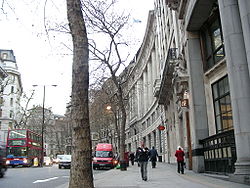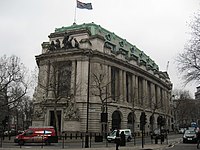Aldwych
| Aldwych | |
| Middlesex | |
|---|---|

| |
| Location | |
| Grid reference: | TQ307810 |
| Data | |
| Local Government | |
| Council: | Westminster |
Aldwych (pronounced ˈɔːldwɪtʃ) is an old village of Middlesex at the western edge of the City of London (now within the City of Westminster), at the heart of the conurbation such that its own identity is largely lost between the two cites. This village though was London in Anglo-Saxon days, before King Alfred the Great moved the city wholesale within the ancient Roman walls, leaving the old location as the 'old settlement'; eald wic.
Aldwych today is a locality once more at London's heart, where many important routes run and grand buildings stand. Its heart is the D-shape formed by the Strand, which runs between London and Westminster, and the crescent road named Aldwych, which meets the Strand at its eastern and western ends. The broad thoroughfare of Kingsway runs north from Aldwych.
Description
Aldwych stands at the western edge of the City, from Temple Bar westward and of the Inner Temple. The main roads are the Strand, and Aldwych looping behind it, with Kingsway heading off north. On the side leaving down to the River Thames are King's College, London, The Courtald Institute and Somerset House. Further west upriver is the Precinct of the Savoy. Covent Garden may be included in Aldwych also, by historical right, bringing a substantial area under under the description, but this part of town is such a jumble of contiguous neighbourhoods that a western or northern boundary is impossible to place on the name of Aldwych.
Aldwych, the road, is a crescent, connected to the Strand at both ends. At its centre, it meets Kingsway. The most prominent buildings along this road are India House and Australia House (the High Commissions of India and Australia respectively) and Bush House; former headwquarters of the BBC World Service, by which is Centrium, formerly Television House. Other buildings along Aldwych the Waldorf Hilton hotel, the Aldwych Theatre, various buildings belonging to the London School of Economics and the Gaiety Theatre.
Nearby, in the Strand, is the now-disused Aldwych tube station. There was also an Aldwych tramway station in the high days of the tram.
Churches

The main churches of the Church of England in Aldwych are both on the Strand:
- St Mary le Strand and
- St Clement Dane's, the latter now known formally as the Central Church of the Royal Air Force but popularly known by its old name; in the children's rhyme "Oranges and lemons say the bells of St Clements".
Including Covent Garden there is:
- St Paul's Covent Garden
The Church of Scotland has a church in Covent Garden also: Crown Court Church
History
In the early Anglo-Saxon period the old Roman city of London was left largely abandoned and a new London grew up unconstrained by the walls to the west, which took the name of London (or Lunden in Old English). London in this age is variously referred to as Lunden, Lundenwic and Lundenburg and Lundenceaster. The town stood where Aldwych is today; it may have been the favoured location as the mouth of the River Fleet provided a sheltered harbour for trading ships and fishing boats.
In the ninth century, Vikings struck England repeatedly and London was a keenly sought target, so King Alfred, as Asser relates, moved London eastwards within the Roman walls of ancient Londinium for better defence, and this is where the City of London remains today. The old town or eald wic outside the wall became 'Aldwych.
The name is recorded as Aldewich in 1211.

Lundenwic was rediscovered in the 1980s after the results of extensive excavations were reinterpreted as being urban in character. These conclusions were reached independently by the archaeologists, Alan Vince and Martin Biddle. Recent excavations in the Covent Garden area have uncovered an extensive settlement, covering about 150 acres, stretching from the present-day National Gallery site in the west to Aldwych in the east.[1]
The modern street was created in a redevelopment in the early twentieth century, that saw the demolition of the old Wych Street and the construction of Australia House (built 1913-18) and Bush House (completed in 1925).
On 18 February 1996, a bomb detonated on a Number 171 bus travelling along Aldwych, killing Edward O'Brien, the IRA terrorist transporting the device; it also injured four others.
Outside links
| ("Wikimedia Commons" has material about Aldwych) |
